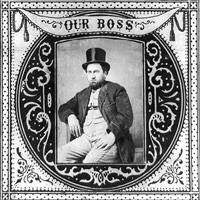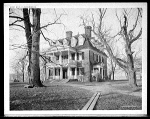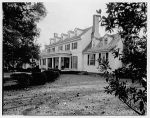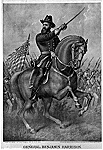Today in History: December 4
Boss Tweed Escapes!
There was Tweed;
Under his rule the ballot-box was freed!
Six times as big a vote he could record
As there were people living in the ward!W.A. Croffut,
"Bourbon Ballads,"
America Singing: Nineteenth-Century Song Sheets

Our Boss, Tobacco label showing Boss Tweed, copyright 1869.
Prints & Photographs Online Catalog
On December 4, 1875, William M. "Boss" Tweed, notorious leader of New York City's Democratic political machine, escaped from the Ludlow Street jail where he was being held and went into hiding in New York, while a civil case against him for misuse of city funds went forward. After Tweed was found guilty in absentia, he fled to Spain, where he was quickly captured and returned to New York City to serve out his sentence.
Tweed, a former bookkeeper, businessman, and member of several fraternal organizations, including the Masons, was elected an alderman in New York City in 1851. He was subsequently elected to the U.S. House of Representatives for one term (1853-55). He then returned to local politics and worked his way up New York City's Democratic hierarchy by holding various elected and unelected positions in the municipal government.
Tammany Hall, the executive committee of the New York City Democratic Party, was the center of the political machine that Tweed dominated, and which controlled much of New York City government. Through a system of patronage and charity, Tammany Hall commanded the allegiance of many voters, particularly recent immigrants and the poor. Poor citizens relied on the party for access to employment, and financial and legal assistance; in return, they were expected to vote in support of Tammany candidates and party initiatives.
The New York Times, Harper's Weekly cartoonist Thomas Nast, and reforming Democrat Samuel J. Tilden all contributed to the effort to oust Tweed from office. On July 22, 1871, the New York Times began publishing an exposé of the Tweed Ring's activities. Nast followed up with cartoons roasting Tweed. Despite bribes and threats, Nast continued to lambast Tweed regularly in the pages of Harper's. Meanwhile, Tilden's efforts to oust Tweed solidified his name as a reformer—a reputation that helped him become governor of New York in 1874 and nearly put him in the White House in 1877.

Tweed-le-dee and Tilden-dum,
Thomas Nast, Artist,
Illustration in Harper's Weekly, July 1, 1876.
Prints & Photographs Online Catalog
To learn more about William M. Tweed and Tammany Hall:
- Search the collection Nineteenth Century in Print: Periodicals Tammany.
- Search the Library’s Prints and Photographs Online Catalog on keywords such as Tammany, Thomas Nast, and William Tweed.
- View film footage of Tammany sachem Dick Croker. According to the Edison films catalog, Dick Croker Leaving Tammany Hall provides, "a very lifelike picture of the famous New York politician and Tammany Hall boss." Find this film by searching the collection Inventing Entertainment: The Motion Pictures and Sound Recordings of the Edison Companies on Tammany.
- Search An American Time Capsule: Three Centuries of Broadsides and Other Printed Ephemera on Tammany to find documents relating to Tammany Hall’s early days.
- Search Chronicling America: Historic American Newspapers (1897-1910) on phrases such as Tammany Hall and Thomas Nast to view related articles from the early part of the twentieth century.
- Search Historic American Sheet Music, 1850-1920 on Tilden or Tammany to find the songs Tilden and Reform (1876) and Tammany; A Pale Face Pow-Wow (1905).
A Day of Thanksgiving

William Henry Harrison Residence,
"Berkeley," in Viriginia, Exterior,
Samuel H. Gottscho, photographer,
November 14, 1961.
Architecture and Interior Design for 20th Century America: Photographs by Samuel Gottscho and William Schleisner, , 1935-1955
On December 4, 1619, thirty-eight colonists arrived from England and ventured ashore to settle the land grant along the James River that became known as the Berkeley Hundred (Berkeley Plantation). They observed a prayer of Thanksgiving for their safe passage to the New World.
Soon, the landing party--including a sawyer, a cooper, a shoemaker, a gunmaker, and a cook--set about constructing a storehouse and an assembly hall for the plantation. December 4 became a day of Thanksgiving at Berkeley, "yearly and perpetually kept holy" as the plantation charter directed.
Berkeley Plantation, built for the family of Benjamin Harrison IV in 1726, was one of several impressive James River plantations constructed during the first part of the seventeenth century. Nearby Shirley Plantation, begun in 1613—although construction of the present mansion dates to 1723, was the birthplace of Ann Hill Carter, mother of Civil War general Robert E. Lee. Sherwood Forest, erected in 1730, was the home of President John Tyler.

Shirley [Plantation], James River, Va.,
William Henry Jackson, photographer,
between 1900-06.
Touring Turn-of-the-Century America: Photographs from the Detroit Publishing Company, 1880-1920

John Tyler Sherwood Forest, Residence in, Virginia, Exterior,
Samuel H. Gottscho, photographer,
November 10, 1961.
Architecture and Interior Design for 20th Century America: Photographs by Samuel; Gottscho and William Schleisner, 1935-1955
Benjamin Harrison V, born at Berkeley Plantation on December 13, 1730, signed the Declaration of Independence and served three terms as governor of Virginia. His son, the ninth President of the United States, William Henry Harrison, also was born at the plantation. Just a month after his inauguration, however, Harrison died in office and was succeeded by Charles City County neighbor and vice president, John Tyler. In 1888, William Henry Harrison's grandson, Benjamin, entered the White House as the twenty-third president.
During the Peninsular Campaign of the Civil War, General George B. McClellan made Berkeley Plantation his headquarters. While stationed at Berkeley, Major General Daniel Butterfield composed the bugle call "Taps" in 1862.

General Benjamin Harrison—"Come on Boys!", General Benjamin Harrison—"Come on Boys!", Battle of Resaca-May 13th to 16th 1864,
lithograph, Kurz and Allison, 1888.
By Popular Demand: Portraits of the Presidents and First Ladies, 1789-Present
- Search the collection Documents from the Continental Congress and Constitutional Convention, 1774-1789 on Harrison to retrieve documents pertaining to Benjamin Harrison, revolutionary patriot, and ancestor of two American presidents.
- View additional photographs of the facade and rooms of the Harrison and Tyler homes. Search on Berkeley or Sherwood Forest in Architecture and Interior Design for 20th Century America: Photographs by Samuel Gottscho and William Schleisner, 1935-1955 as well as in the Prints & Photographs Online Catalog.
- Early Virginia Religious Petitions presents images of 423 petitions submitted to the Virginia legislature between 1774 and 1802. View a petition dated October 22, 1793 in which Quakers from Charles City ask relief from various religious levies. Interestingly, Thomas Jefferson's 1786 Act for Establishing Religious Freedom should have prevented these incursions on the religious liberty of the Society of Friends.
- Read more about U.S. presidents including Thomas Jefferson, Abraham Lincoln, and James Madison. Search the Today in History Archive on the name of your favorite chief executive.
Goodbye to General Washington

George Washington, Full-length portrait,
Gilbert Stuart, painter,
Photograph of Painting,
[between 1900-20].
Touring Turn-of-the Century America: Photographs from the Detroit Publishing Company, 1880-1920
With a heart full of love and gratitude, I now take leave of you. I most devoutly wish that your latter days may be as prosperous and happy as your former ones have been glorious and honorable. I cannot come to each of you, but shall feel obliged if each of you will come and take me by the hand.General George Washington's Farewell to his Officers, from Memoir of Colonel Benjamin Tallmadge
On Thursday, December 4, 1783, General George Washington received the officers of the victorious Continental Army to say farewell in the Long Room of Fraunces Tavern, located on the corner of Pearl and Broad streets, in lower Manhattan. Fraunces Tavern opened in 1762 as the "Queen's Head Tavern" and also was known as the “Sign of Queen Charlotte”—for its portrait of the queen. The tavern, under the proprietorship of Samuel Fraunces--a patriot of African and French extraction born in the French West Indies, was located across the Bowling Green from the Whitehall Ferry landing. There, a barge waited to carry Washington across the Hudson River to New Jersey and then to Annapolis to resign his commission.

Fraunces Tavern, 1762, Tallmadge Memorial, New York, New York.
[between 1900-15].
Touring Turn-of-the-Century America: Photographs from the Detroit Publishing Company, 1880-1920
Until British troops evacuated the city on November 22, 1783, Fraunces Tavern was called the "Queen's Head Tavern." Its sign incorporated a portrait of Queen Charlotte.
After British troops evacuated the city on November 25, 1783, Governor George Clinton threw a huge party at the tavern in honor of General Washington. On December 1, a display of "fire-works and illuminations" was viewed from the Battery.
All the festivities were reported in the newspaper published by James Rivington, formerly "Printer to the King's Most Excellent Majesty." With the departure of the British, The Royal Gazette became Rivington's New-York Gazette, and Universal Advertiser. The December 6, 1783, issue of the newspaperdescribed Washington’s farewell to his officers:
Last Thursday noon (December 4), the principal officers of the army in town assembled at Fraunces Tavern, to take a final leave of their illustrious, gracious, and much loved Comrade, General Washington. The passions of human nature were never more tenderly agitated, than in this interesting and distressful scene…[His] words produced extreme sensibility on both sides…Rivington's New-York Gazette, and Universal Advertiser, December 6, 1783.

Major-General Henry Knox, Three-quarter-length Portrait,
Gilbert Stuart, painter,
Photograph of a painting done 1800, Museum of Fine Arts, Boston.
c[between 1900 and 1912].
Touring Turn-of-the-Century America: Photographs from the Detroit Publishing Company, 1880-1920
According to Colonel Benjamin Tallmadge's account, General Henry Knox stood closest to General Washington. As the general concluded his address, the two turned to each other and "suffused in tears…embraced each other in silence." Then, each of the officers followed suit, afterwards following Washington to the ferry landing where he departed, waving to them from his barge.
General Washington had already issued his Farewell Orders to the Continental Army. The outpouring of emotion and affection for Washington upon his retirement to Mt. Vernon for Christmas imposed a heavy burden of reciprocal correspondence. The general authored many letters of recommendation for former soldiers and patriots including a testimonial for Samuel Fraunces, who likely assisted the Continental Army by obtaining intelligence from British army officers frequenting his tavern while New York was under royal government. Fraunces later was employed by Washington as a steward in his presidential households in New York and Philadelphia.
- Read Washington’s correspondence. Search the collection George Washington Papers at the Library of Congress, 1741-1799 on Fraunces, Tallmadge, or Knox to find a wealth of material including documentation of Washington's expenditures at the tavern. Search the collection on Washington farewell to locate more words from Washington at the time of his retirement. View the Time Line and the Essays in the collection for additional biographical information about Washington.
- Search Documents from the Continental Congress and the Constitutional Convention, 1774-1789 on army for material related to the Continental Army including a document repealing "rations, subsistence, or allowances to officers over and above their pay."
- Search the Today in History Archive on George Washington to learn more about the first president. Features highlight the president's birthday, his resignation as commander-in-chief of the Continental Army, and his death.